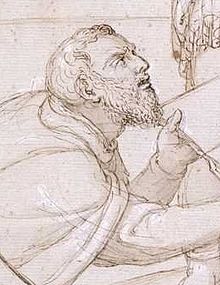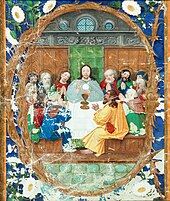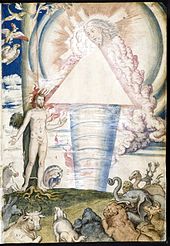Francisco de Holanda
Francisco de Holanda (born September 6, 1517 in Lisbon , † June 19, 1585 there , earlier often also Francisco de Hollanda , Francisco d'Olanda or Francisco d'Ollanda ) was a Portuguese painter , architect , antiquarian , historian and art theorist .
Life
Like his father António de Holanda , who comes from a Dutch family and lives in Lisbon , Francisco began his artistic career as a miniaturist . Between 1538 and 1547 he stayed in Rome to study antiquity (where he came to work alongside Pedro Mascarenhas ). There he was demonstrably in contact with prominent figures such as Michelangelo , Perino del Vaga , Sebastiano del Piombo , Giulio Clovio , Parmigianino and Vittoria Colonna . In the Roman years, Francisco de Holanda drew numerous ancient buildings in the city, like several other graphic manuscripts by the artist, this bundle is now in the Biblioteca Nacional de España . After his return to the Iberian Peninsula in 1548 he edited the final version of his work Da pintura antiga , which contains his most famous work today, the Diálogos em Roma or Roman dialogues , in which Michelangelo appears as a fictional interlocutor.
In Portugal, Francisco de Holanda was one of the leading artists, not least because of the knowledge he gained from studying antiquity in Italy and his intellectual ambitions. As such, he served several Portuguese kings (namely Heinrich I , Johann III. And Sebastian I ) on various nationwide projects - for example, he was responsible as an architect for the facade of the Igreja de Nossa Senhora da Graça church in Évora . Above all, during his time on the Iberian Peninsula, he carried out other large-scale drawing projects that, analogous to the drawings of ancient Rome, deal with the past and present greatness of Portugal. However, apart from numerous miniatures, his painterly work - including numerous documented portraits - is no longer known or not identified, apart from fragments. Francisco de Holanda died in Lisbon in 1585 .
Reception and importance as an art theorist
Francisco de Holanda counts as an early exception within Portuguese art literature, which only started further noteworthy attempts at the end of the 17th century with Félix da Costa Meessen and then finally in the 18th century with representatives such as José da Cunha Taborda and Cyrillo Volkmar Machado . However, his writings can only partially count as genuine Portuguese literature: In particular, the Diálogos em Roma are primarily treated by research as a component and document of the Italian art discourse of the 16th century, as they are shaped by the questions raised in the first half of the Cinquecentos were negotiated in Rome (for example the Paragone ). Basically, only very few copies of his treatises have been preserved and were only rediscovered and published in print from the late 19th century. There is also no clear evidence of a more intensive reception by contemporaries on the Iberian Peninsula - although it should be mentioned that, for example, Da pintura antiga had already been translated into Catalan by Manuel Denis (also: Diniz) in 1563 .
Among the art theoretical writings of the 16th century, the writings of Francisco de Holanda are among the most important and most frequently cited reference works, which is not least indicated by the constant engagement of non-Portuguese research with the work in the form of numerous annotated translations. My favorite interest is in the Diálogos em Roma , which have often been torn from their original connection with Da pintura antiga in editorial terms; the other (perhaps historiographical) works by De Holanda tend to receive very little attention. The reception of the diálogos is to be divided into two phases, since after their discovery by art historical research they were first emphatically understood as direct testimony to Michelangelo's views on art theory, especially since the Divino artista did not leave behind any tractatic writing of its own. Only source-critical investigations, comparisons with other dialogues of the time and the general classification in the literary strategies of this genre in the Renaissance meant that researchers such as Hans Tietze and Julius von Schlosser who demonstrated in the early 20th century on the one hand that the Roman talks at best general Reflect thoughts that circulated around Michelangelo and other Roman artists. On the other hand, however, they also pointed to the discrepancy between modern expectations of such texts and the historical author's intention ("It was not in the least Hollanda's intention to present his dialogues as a historical report, as a faithful reproduction of real conversations [...]. "). Since the realization that "Hollanda's [ sic ] work may not claim the value of a document for Michelangelo's life and nature, or only in a highly conditional manner," the author's views on art theory have become, like other works (such as Leonardo's Trattato della Pittura or Vasaris Vite ) construed and autonomous discussed, for example, individual aspects such as the Plato reception De Holandas.
Literary work
Complete edition
-
Obra completa. Introdução, notas e comentários de José Da Felicidade Alves. 4 vols. Livros Horizonte, Lisbon 1984:
- Since pintura antiga. ( Obra completa , 1).
- Diálogos em Roma. ( Obra completa , 2).
- Do tirar polo natural. ( Obra completa , 3).
- Da fábrica que falece à cidade de Lisboa. ( Obra completa , 4).
Original language single editions
- Since pintura antiga. Livros 1 & 2. Ed. By Angel Gonzalez Garcia. Lisbon 1983.
- Os desenhos das antigualhas que vio Francisco d'Ollanda, pintor portugués (... 1539 - 1540 ...). Publicalos, con notas de estudio y preliminares el Prof. E. Tormo. Reproducción facsimil del codice de Francisco d'Ollanda que se custodia en la Biblioteca del Escorial. Madrid 1940.
- Since pintura antiga. Ed. completa d'esta celebre obra. Commentada por Joaquim de Vasconcellos . Renascença Portuguesa, Porto 1930.
Bilingual single editions
- Dialoghi di Roma. Introduzione, comment and note from Rita Biscetti. Bagatto Libri, Rome 1993 (text in Portuguese / Italian).
- Achille Pellizzari (Ed.): Le opere di Francisco de Hollanda edite nel testo portoghese e nella traduzione spagnola e illustrate con introduzione, versioni e note e con la riproduzione integrale del codice dei disegni delle 'Antichità d'Italia' conservato nella Biblioteca dell ' Escuriale. 2 vol. Perrella, Naples 1914–1915 (incomplete, only I quattro dialoghi intorno alla pittura antica and an illustrated book published) (text in Portuguese / Spanish).
- Four conversations about painting, held in Rome in 1538. Original text with translation, introduction, supplements and explanations by Joaquim de Vasconcellos . Graeser, Vienna 1899 ( Sources for Art History and Art Technique of the Middle Ages and Modern Times , 9) (Text Portuguese / German).
Translated individual editions
- I Trattati d'arte. A cura di Grazia Modroni. Sillabe, Livorno 2003 (Arte e memoria, 6).
- Diálogos em Roma (1538). Conversations on art with Michelangelo Buonarroti. Edited by Grazia Dolores Folliero-Metz. Winter, Heidelberg 1998.
- Colloqui con Michelangelo. A cura di Emilio Radius. Antonioli, Milano 1945 (Collezione storica del Condor. Clio Minore, 3).
- I dialoghi michelangioleschi. Traduzione dal portoghese con introduzione, cenni biografici, note e appendici di Antonietta Bessone Aurelj. 3rd ed. Maglione, Rome 1939.
- Four dialogues on painting. Rendered into English by Aubrey FG Bell. Oxford University Press, Oxford 1928.
- De la pintura antigua (1548). Versión castellana de Manuel Denis (1563). J. Ratés Impresor, Madrid 1921.
literature
- Raphael Fonseca: Francisco de Holanda: uma revisão historiográfica. In: Revista de história da arte e arqueologia , Vol. 15, 2011, pp. 29-50
- Sylvie Deswarte-Rosa: Francisco de Holanda (1517 - 1584), collectionneur portugais de dessins et de gravures au temps de Michel-Ange. In: Catherine Monbeig Goguel (ed.): L'artiste collectionneur de dessin. De Giorgio Vasari à aujourd'hui. Continents Editions, Milan 2006, pp. 101–128.
- Elisabetta Di Stefano: Arte e idea. Francisco de Hollanda e l'estetica del Cinquecento. Centro Internazionale Studi di Estetica, Palermo 2004 (Aesthetica preprint. Supplementa, 12).
- Cristiane Nascimento: Da pintura antiga de Francisco de Holanda. O encômio como gênero de prescrição e da arte. In: Luiz Marquez (Ed.): A constituição da tradição clássica. São Paulo 2004, pp. 167-188.
- Sylvie Deswarte-Rosa: Vittoria Colonna and Michelangelo in San Silvestro al Quirinale in the talks of Francisco de Holanda. In: Vittoria Colonna. Michelangelo's poet and muse. Skira Editore, Milan 1997, pp. 349-373.
- José da Felicidade Alves: Introdução ao estudo da obra de Francisco d'Holanda. Livro's horizons, Lisbon 1986.
- Sylvie Deswarte-Rosa: Francisco de Holanda collectionneur (1514 ou 1518 - 1572). In: Revue du Louvre , Vol. 34, 1984, pp. 169-175.
- JB Bury: Two Notes on Francisco de Holanda. The Warburg Institute , London 1981.
- Jorge Segurado: Francisco d'Ollanda. Da sua vida e obras, arquitecto da Renascença ao serviço de D. Joao III., Pintor, desenhador, escritor, humanista. Ed. Excelsior, Lisbon 1970.
- Eugenio Battisti : Note su alcuni biografi di Michelangelo. In: Scritti di storia dell'arte in onore di Lionello Venturi . De Luca, Rome 1956, pp. 321-339.
- Julius von Schlosser : The art literature. A handbook for source studies in modern art history . Schroll, Vienna 1924 (Unchanged reprint. Ibid 1985, ISBN 3-7031-0604-2 ), esp. Pp. 246-250.
- Hans Tietze : Francisco de Hollanda and Donato Giannotti's dialogues and Michelangelo. In: Repertorium für Kunstwissenschaft , 28, 1905, pp. 295-320.
Individual evidence
- ↑ On the fact that the art theoretical ideas circulating in Rome are reflected in the diálogos , cf. E.g. Roland Kanz: The Art of Capriccio. Creative obstinacy in the Renaissance and Baroque. Deutscher Kunstverlag , Munich a. Berlin 2002, p. 196: "Hollanda [ sic ] should have been thoroughly informed about current views in Rome and thus presumably reflect the opinion common at the end of the 1530s".
- ↑ Tietze 1905, p. 304. Similar to Schlosser 1924, pp. 248–249 (with an overview of the older view).
- ↑ Schlosser 1924, p. 249
Web links
| personal data | |
|---|---|
| SURNAME | Holanda, Francisco de |
| ALTERNATIVE NAMES | Hollanda, Francisco de; Olanda, Francisco d '; Ollanda, Francisco d ' |
| BRIEF DESCRIPTION | Portuguese painter, architect, antiquarian, historian and art theorist |
| DATE OF BIRTH | September 6, 1517 |
| PLACE OF BIRTH | Lisbon , Portugal |
| DATE OF DEATH | June 19, 1585 |
| Place of death | Lisbon , Portugal |


